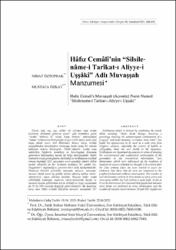Hâfız Cemâlî’nin “Silsilenâme-i Tarîkat-ı Aliyye-i Uşşâkî” Adlı Muvaşşah Manzumesi
Citation
ÖZTOPRAK, Nihat & Mustafa ÖZKAT. "Hâfız Cemâlî’nin “Silsilenâme-i Tarîkat-ı Aliyye-i Uşşâkî” Adlı Muvaşşah Manzumesi". İnsan & Toplum, 1.26 (2021): 448-490.Abstract
Zincir, bağ; soy, sop, sülâle; bir zürriyet veya neslin
kesintisiz devamını gösteren şecere” gibi anlamlara gelen
“silsile” kelimesi ile “risale, kitap, mektup” anlamındaki
“nâme” kelimesinin birleşimiyle oluşan silsile-nâme, hadis ilmi
başta olmak üzere dinî ilimlerden hüsn-i hatta, tarikat
meşâyihinden hanedanlara varıncaya kadar geniş bir sahada
kullanım imkanı bulmuştur. Silsile-nâmeler, neslin veya
nakledilen bilgilerin kesintisiz ve bozulmadan devamını
göstermesi bakımından önemli bir belge niteliğindedir. Hadis
ilmindeki isnad geleneğinden etkilendiği ve tarikatların teşekkül
etmeye başladığı XIII. yüzyıldan sonra yazıldığı tahmin edilen
tarikat silsileleri de her tarikatın kesintisiz bir şekilde Hz.
Peygamber’e bağlandığını gösteren birer delil hüviyetindedir.
Tasavvuf kültürü içerisinde manzum, mensur, manzummensur olmak üzere üç şekilde kaleme alınmış tarikat silsilenâmelerinin sayısı oldukça fazladır. Bugüne kadar tespit
edilebildiği kadarıyla manzum silsile-nâmelerde kaside ve
mesnevi nazım şekillerinin tercih edildiği ve beyit sayılarının
da 20 ila 150 arasında değiştiği gözlenmektedir. Bu makaleye
konu olan Hâfız Cemâlî Kâsım’ın mesnevi tarzındaki 297 beyitlik Uşşâkî tarikatı silsile-nâmesi de bu türün
örneklerindendir. H. 25 Zilhicce 1305 (2 Eylül 1888) tarihinde
tamamlanmış olan silsile-nâme, gerek hacminin genişliği
gerekse kafiyeli sesleri esas alınarak “muvaşşah” (akrostiş)
tarzda düzenlenmiş olmasıyla türün diğer örnekleri arasında
dikkat çekmektedir. Sırasıyla “Besmele”, “Fâtiha”, “İhlâs” ve
“Sâffât” sûresinin son üç âyetinin harflerinin kafiye olarak
seçildiği bu eser, Türk edebiyatında “silsile-nâme” türü yanı
sıra “muvaşşah” türü açısından da büyük önem arz etmektedir.
Çalışmada söz konusu eserin transkripsiyonlu olarak çevirisi
yapılmış; şekil ve muhteva açısından incelenmesinin yanı sıra
Türk edebiyatında “silsile-nâme” ve “muvaşşah” türü hakkında
da kısa değerlendirmelerde bulunulmuştur. Silsilename which is formed by combining the words
silsile meaning “chain, bond; lineage, ancestry; a
genealogy showing the uninterrupted continuation of a
progeny” and name meaning “a treatise, book, letter”, has
found the opportunity to be used in a wide area from
religious sciences, especially the science of hadith to
calligraphy, from the sect sheikh to the dynasties.
Silsilenames are important documents in terms of showing
the uninterrupted and undistorted continuation of the
generation or the transmitted information. Sect
silsilenames which were influenced by the tradition of
isnad in the science of hadith are thought to be written after
the 13th century when the sects started to occur are
evidences that show that all sects are connected to the
prophet Muhammad without interruption. The number of
sect silsilenames written in three forms as verse, prose and
verse-prose within the Sufi culture is quite high. As far as
it can be determined, it is observed that qasida and masnavi
verse forms are preferred in verse silsilenames and the
number of couplets varies between 20 and 150. Uşşâkî sect silsilename in the masnavi style that consists of 297
couplets by Cemâlî Hâfız Kâsım which is the subject of this
article, is one of the examples of this genre. The silsilename,
which was completed on H. 25 Zilhijja 1305 (2 September
1888), draws attention among other examples of the genre,
with its large volume and being arranged in the
"muvaşşah" (acrostic) style based on rhyming sounds.
This work, in which the letters of the last three verses of the
surah "Basmala", "Al-Fatiha", "Al-Ikhlas" and "Saad"
are chosen as rhymes, is of great importance in terms of the
“silsilename” genre as well as the "muvaşşah" genre in
Turkish literature. In the study, the work in question is
written in transcription alphabet; also in addition to
examining it in terms of form, content and language, short
evaluations were made about the genre of "silsilename"
and "muvaşşah" in Turkish literature.



















